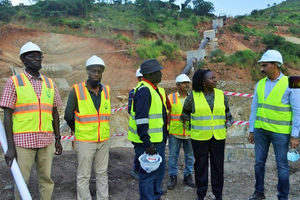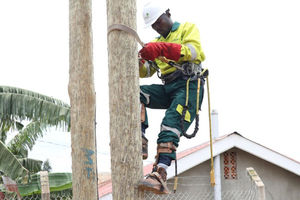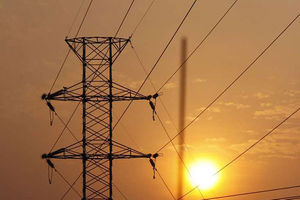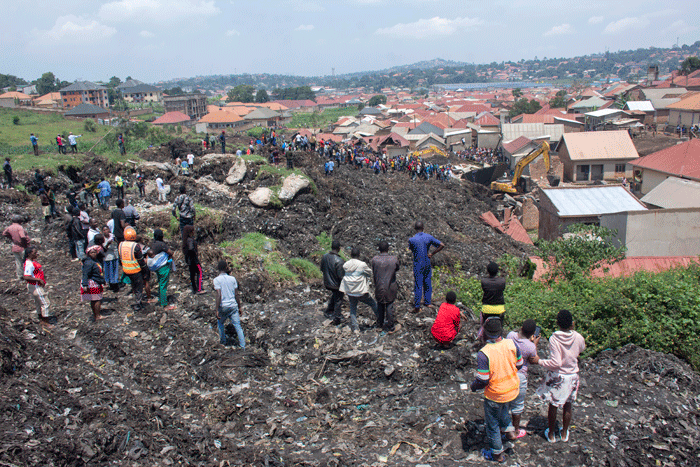
When the Yesu-Dit Cooperative Society in Parombo Sub-County, Nebbi District, installed a cassava processing plant a few years ago, it hoped to spark higher productivity among its 1,200 members by adding value to their produce.
Production rose as more farmers planted cassava, but the hope and enthusiasm did not last.
The processing plant needed power, which came from a diesel generator provided as part of the government-run, World Bank-funded Agricultural Cluster Development Programme.
Soon, however, the cost of water needed in the production process and that of running the generator burnt through any profits.
“We buy water at Shs300 per jerrycan and in a month, we spend about Shs300,000,” says Louis Onen, the chairperson of the cooperative society.
“We also need 40 litres of diesel fuel per day in a month, we spend Shs1.5m. We cannot realise any profit if all this is for running costs.”
The plant, which can process 500 kilogrammes of cassava per hour, was soon abandoned.
There are many similar anecdotes about the high cost of doing business in the West Nile Sub-region.
Distance matters – the biggest town in the region, Arua, is almost 500 kilometres from the capital,
Kampala – but the biggest obstacle has been the lack of access to cheap and reliable electricity supply.
Despite West Nile having 12 districts and Arua City, whose population of 3.8 million people is only second to Kampala, the region only had 24,000 power customers connected to a small, isolated grid.
Now there is light at the end of the dark tunnel. President Museveni is tomorrow expected to preside over a ceremony to plug West Nile Sub-region into the grid serving the rest of the country.
The President will commission the Kole, Gulu, Arua, and Nebbi transmission lines and switch the region to the national grid at Nebbi sub-station.
Plug and play
The key artery is a 289-kilometer, 132-kilovolt transmission line that snakes across Kole, Oyam, Omoro, and Nwoya districts, then crosses into West Nile.
The transmission line starts with a huge substation of 132KvA that receives the national grid from Lira.
The Gulu substation feeds to Olwiyo interconnection substation and later will feed into Nebbi substation.
From Nebbi, the power will be transmitted to Arua sub-station at Muni, which will then transmit power to other parts of West Nile.
Newly built 132/33kilovolt substations in Gulu, Nebbi, and Arua equipped with advanced transformers and switchgear systems will ensure reliable supply.
The connection also includes the construction of 120-meter-high transmission towers across the River Nile at Pakwach.
The last-mile connections will run through the West Nile Rural Electrification Company, which has been distributing power in West Nile for two decades.
This way, the national grid will be connected to nine districts in West Nile: Pakwach, Nebbi, Zombo, Madi Okollo, Arua district, Arua City, Terego, Koboko, and Yumbe.
Feasibility studies are still ongoing on how to connect Obongi district, either from Yumbe or via Moyo or Adjumani districts. Adjumani and Moyo districts, both in West Nile, will continue to be served from the line from Gulu that was connected more than 10 years ago.
Addressing residents in Yumbe District two months ago, the Minister of Energy and Mineral Development, Ms Ruth Nankabirwa, said the grid connection will bring stable power to an additional [43,827] people in the 12 West Nile districts as part of the Electricity Access Scale-Up Project.
She said Moyo will have 1,067 new consumers; Arua 8,388; Koboko 4,006; Maracha 3,947; Madi-Okollo 2,423; Pakwach 2,748; Nebbi 4,484; Yumbe 8,383; Zombo 4,206; Terego 3,435; and Obongi 742.
“We’ll connect all homes that are close to the existing line but can’t connect themselves,” he said.
The State Minister for Energy and Mineral Development, Ms Phiona Nyamutoro, confirmed the readiness of the plan.
“Nebbi sub-station is fully energised.

A technical team from Ministry of Energy and Mineral Development inspects the Nebbi sub-station. PHOTO/PATRICK OKABA
Now waiting to have the switch turned on connecting West Nile to the national grid,” she said.
The project to strengthen the grid in West Nile and connect it to the rest of the national grid is funded by a $100 million (Shs370 trillion) loan from the World Bank
Politics of power
West Nile’s lack of connection to the national grid has long been a political issue and cost the government electoral support.
The Nebbi District Youth Chairperson, Mr Savior Rwothomio, said the connection to the national grid will attract investors and boost trade and commerce.
“This is going to be a great opportunity for the young people to come up with good cottage industries proposals which can attract grants from both government and donors to increase the level of employment in the region,” he said.
He said inadequate power supply had frustrated and failed many local investors.
Notable investments that suffered the fate of high costs of power include Agu mineral water plant in Zombo district, Nile Foam Mattress, 7 Hills Adrikos, Malaika Bread and Mineral Water, among others.
In the region, Obongi District has remained isolated without any power connection.
The locals chiefly rely on generators and solar for businesses and in health centres.
The Obongi County MP, Dr. George Bhoka, said: “We are failing to tap into the potential from West Nilers in the diaspora who are willing to establish infrastructure here but cannot.
Should we continue to wait for loans from the World Bank to connect power? The electronic systems in local governments, schools, health centers need adequate electricity.
Several businesses in Obongi are crippled because of no power.”
The MP of Ayivu East Constituency in Arua City, Mr Geoffrey Feta, said the region is craving a national grid because it has lagged behind in development.
Due to the insufficient supply of electricity by West Nile Rural Electrification Company over the years, a pressure group was formed to kick them out of the region and advocate for connection to the national grid.
The Nebbi Resident District Commissioner (RDC), Mr Robert Abak, said there was a need for investors to make use of the opportunity to establish factories at the available industrial park land. He revealed that the district had secured over
500 acres of land at Ovoru in NyaravurAngal Town Council for the industrial park, which is available to local investors. “We need to get ready to tap business opportunities which can attract foreign investors with stable electricity power and reduce unemployment rate in the region,” Mr Abak said.

Technicians at Olwiyo substation line where power will be transmitted to connect West Nile. PHOTO/ FELIX WAROM OKELLO
History of Darkness
The lack of reliable electricity supply to the West Nile region has its roots in colonial history.
Before 1914, the region was part of what was then Boga Zaire (now the Democratic Republic of Congo) and under Belgian colonial rule.
The Belgians surrendered the region to become part of Uganda, then a British Protectorate, in 1914 as part of the Ngurudoto agreement.
Electricity supply in the protectorate was initially tentative and small scale.
In 1906 the Uganda Company opened the first powered ginnery near Kampala and the first thermal power station was introduced in 1915.
It was not until 1954 that the country’s first major hydropower plant was opened at the Owen Falls Dam in Jinja on the River Nile.
The plant remains in operation and has been boosted by the nearby Kiira Dam, as well as other dams on the River Nile at Bujagali, Isimba and Karuma, which is nearing completion. Karuma is the nearest to the West Nile region.
With support from the World Bank, the government identified the region’s lack of reliable electricity access as a handicap and tendered out the West Nile Electrification project in 2002.
In 2003 the West Nile Region Electricity Company, Wenreco, was given a 25-year licence to build, own, and operate a stand-alone isolated grid.
The company is a subsidiary of Industrial Promotion Services, which is part of the Aga Khan Fund for Economic Development.
The licence allowed Wenreco to generate, distribute and sell electricity in West Nile.
The initial catchment area covered Arua and Nebbi districts, but this later expanded to all districts in the region.
In 2004, Wenrenco installed a 1.5-megawatt heavy fuel oil plant replacing the old generators. Within a year the supply of electricity increased from four to 18 hours a day on average, although it wasn’t always on.
In 2007 the company started construction of the 3.5MW Nyagak 1 hydropower project which was completed and commissioned in September 2012.
COST OF POWERLESSNESS
Bob Oyoma is a local investor in Parombo Town Council, in Nebbi District.
He produces local wines and is the proprietor of Oyoma General Stores Limited.
Mr Oyoma has huge markets in West Nile, Gulu, Nwoya, and the Democratic Republic of Congo, which is a few kilometers away.
His factory produces 8,000 cartons of different types of packaged wine per day but this drops to 5,000 cartons when there is a power shortage.
“Currently, I am paying a power bill of Shs33 million to Wenreco every month. And when there is no power supply, I spend about Shs10 million for fuelling a generator,” Mr Oyoma told Daily Monitor.
He says due to unstable and unreliable power he is unable to meet market demand for his products and estimates that spends more than Shs400 million per year in generator fuel costs and maintenance.
“Once connected to the grid, it will reduce fuel costs because we expect it to be stable and run machines for longer hours.
Generators would only be for standby,” he added.
Mr Oyoma is looking forward to expanding production if the stable power is also cheaper.
“The region is going to be connected to the national grid but are people going to be connected at reduced cost? Because people are waiting to see whether the connection fees are going to be subsidised,” he said.
POWER CONSUMER GROWTH IN NUMBERS
In 2002, there were 984 consumers supplied by Uganda Electricity Board (UEB)In 2003, Wenreco took over from UEB with 984 consumers in 2012, about 3,563 customers were connected to WenrecoIn 2015, the customers increased to 7,841 In 2016, there were 12,000 consumers In 2018, there were 15,741 consumers In 2021, Wenreco is supplying 21,397 consumers.








